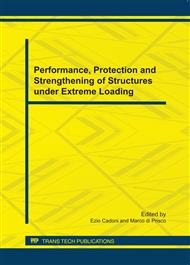p.86
p.92
p.100
p.106
p.112
p.118
p.124
p.130
p.136
Influence of Fibre Shapes on Dynamic Compressive Behaviour of Fibre Reinforced Concrete
Abstract:
In this paper results are reported of impact tests performed to study the influence of different fibre types on dynamic compressive properties of fibre reinforced concrete (FRC). FRC specimens are prepared with the same concrete and 1% of fibres of different types. The compressive impact tests are conducted with an instrumented drop weight impact system consisting of a hard steel drop weight, two 180t fast response loadcells, a high speed video camera, and a fast response data acquisition system. In this study, six fibre types with different shapes and material properties are considered. They are synthetic fibres, undulated, cold rolled, flattened, hooked end and a new spiral shape steel fibres. The dynamic stress-strain relationship is obtained by fitting the load history from the bottom loadcell to the average strain history captured by the strain gages. The energy absorption capabilities are defined as the area under the stress-strain curve of FRC specimens. The performance of the new spiral shape steel fibre is discussed by comparing the test results with those obtained from specimens reinforced with other types of fibres. The influence of the fibre shapes on the failure modes, ductility and energy absorbing capacity of FRC is discussed.
Info:
Periodical:
Pages:
112-117
Citation:
Online since:
July 2011
Authors:
Keywords:
Price:
Сopyright:
© 2011 Trans Tech Publications Ltd. All Rights Reserved
Share:
Citation:


